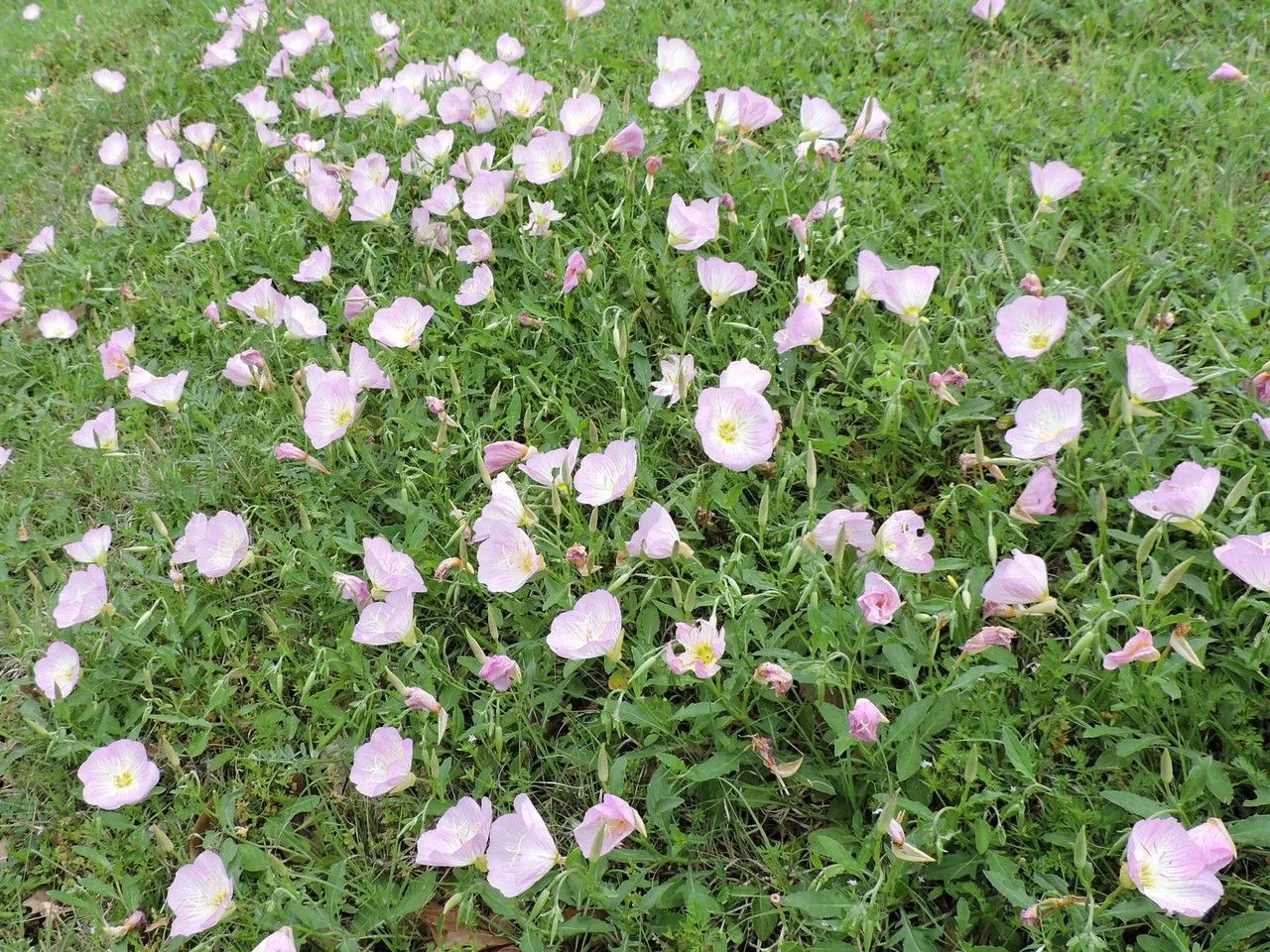
Author: Nutt.
Bibliography: J. Acad. Nat. Sci. Philadelphia 2: 119 (1821)
Year: 1821
Status: accepted
Rank: species
Genus: Oenothera
Vegetable: False
Observations: C. & EC. U.S.A. to N. & C. Mexico
White evening-primrose, scientifically recognized as Oenothera speciosa, is a visually striking flowering plant belonging to the Onagraceae family. This delicate yet vibrant species has captivated botanists and plant enthusiasts since its formal classification was recorded in 1821 in the Journal of the Academy of Natural Sciences of Philadelphia by the noted botanist Thomas Nuttall.
Renowned for its stunning white blossoms, which often exhibit a subtle pink hue as they mature, the White evening-primrose thrives in diverse habitats across central and eastern regions of the United States, extending its reach to northern and central parts of Mexico. This wide geographical distribution underscores the plant’s adaptability to various environmental conditions.
The beauty of Oenothera speciosa lies not only in its aesthetic appeal but also in its unique blooming pattern. True to its common name, the White evening-primrose flowers predominantly during the evening, a characteristic that attracts nocturnal pollinators such as moths. As dusk falls, the petals unfurl, releasing a delicate fragrance that further lures these nighttime visitors.
With its slender stems and lance-shaped leaves, the White evening-primrose provides a graceful addition to wildflower meadows and garden landscapes. It is often employed in xeriscaping due to its drought resistance, making it a sustainable choice for gardeners interested in water conservation.
Ecologically, this plant plays a vital role in its native habitats, offering nourishment to a variety of pollinators while also contributing to soil stabilization with its extensive root systems. Its resilience and adaptability underscore the ecological importance of preserving native species like Oenothera speciosa in the face of changing environmental conditions.
In summary, the White evening-primrose is more than just a visually enchanting plant; it is a species steeped in botanical history and ecological significance. Through its widespread presence from the United States to Mexico, it serves as a testament to the richness of North American flora, deserving admiration and protection for future generations.
Fra: onagre
Eng: pinkladies, white evening-primrose
Deu: prächtige nachtkerze
Hun: pompás ligetszépe
Swe: silvernattljus
En: White evening-primrose, Pinkladies, New Mexico Primrose, Showy evening primrose, Pink evening-primrose, Showy eveningprimrose
Fi: Komeahelokki
Fr: Onagre
De: Prächtige Nachtkerze
Hu: Pompás ligetszépe
Sv: Silvernattljus
Taken Aug 1, 2017 by Angélique Detcherry (cc-by-sa)
Taken Jun 24, 2018 by Pierre Bonnet (cc-by-sa)
Taken Oct 19, 2021 by Guillaume Seidenbinder (cc-by-sa)
Taken Apr 6, 2021 by Monteiro Henrique (cc-by-sa)
Taken Jun 24, 2018 by Pierre Bonnet (cc-by-sa)
Taken May 6, 2020 by Cynthia Brinkley (cc-by-sa)
Taken Sep 12, 2019 by Pierre GUDEL (cc-by-sa)
Taken Jun 5, 2021 by Sabin Poenariu (cc-by-sa)
Taken Oct 5, 2022 by David Hocken (cc-by-sa)
Taken Apr 6, 2021 by Monteiro Henrique (cc-by-sa)
Taken May 18, 2021 by etienne copeaux (cc-by-sa)
Taken May 15, 2011 by Tela Botanica − John DE VOS (cc-by-sa)
Taken Apr 15, 2016 by EOL − Sam Kieschnick (cc-by-nc)
Taken Jun 5, 2021 by Sabin Poenariu (cc-by-sa)
Taken Oct 5, 2022 by David Hocken (cc-by-sa)
Taken May 14, 2020 by fuego (cc-by-sa)
Taken Jul 13, 2019 by Hugues Maillard (cc-by-sa)
Taken Jun 4, 2020 by mohammad shamsi (cc-by-sa)
Taken May 11, 2019 by c l (cc-by-sa)
Taken Jun 13, 2020 by lambert ghis (cc-by-sa)
Taken May 8, 2018 by Philippe Macquet (cc-by-sa)
Taken Jun 1, 2018 by guegafue (cc-by-sa)
Taken Jan 1, 1900 by EOL − W. L. Wagner (cc-by-nc-sa)
Taken May 23, 2019 by marco (cc-by-sa)
Taken Jun 11, 2021 by Miguel A. García (cc-by-sa)
Taken Jan 1, 1900 by EOL − Cooper, G.A. (cc-by-nc-sa)
Taken Apr 5, 2016 by EOL − Nayelli Rivera (cc-by-nc)
Taken Jun 7, 2015 by EOL − Kenneth Bader (cc-by-nc)
Taken Apr 6, 2016 by EOL − ellen hildebrandt (cc-by-nc)
Taken Apr 9, 2016 by EOL − eco2016 (cc-by-nc)
© copyright of the Board of Trustees of the Royal Botanic Gardens, Kew.
© copyright of the Board of Trustees of the Royal Botanic Gardens, Kew.
© copyright of the Board of Trustees of the Royal Botanic Gardens, Kew.
Growth habit: Subshrub, Forb/herb
Family: Myrtaceae Author: (F.Muell.) K.D.Hill & L.A.S.Johnson Bibliography: Telopea 6: 402 (1995) Year: 1995 Status:…
Family: Rubiaceae Author: Pierre ex A.Froehner Bibliography: Notizbl. Bot. Gart. Berlin-Dahlem 1: 237 (1897) Year:…
Family: Sapindaceae Author: Koidz. Bibliography: J. Coll. Sci. Imp. Univ. Tokyo 32(1): 38 (1911) Year:…
Family: Asteraceae Author: A.Gray Bibliography: Pacif. Railr. Rep.: 107 (1857) Year: 1857 Status: accepted Rank:…
Family: Fabaceae Author: Medik. Bibliography: Vorles. Churpfälz. Phys.-Ökon. Ges. 2: 398 (1787) Year: 1787 Status:…
Family: Aspleniaceae Author: (Cav.) Alston Bibliography: Bull. Misc. Inform. Kew 1932: 309 (1932) Year: 1932…